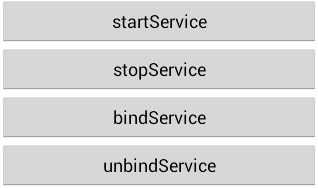Service概念及用途:
Android中的服务,它与Activity不同,它是不能与用户交互的,不能自己启动的,运行在后台的程序,如果我们退出应用时,Service进程并没有结束,它仍然在后台运行,那我们什么时候会用到Service呢?比如我们播放音乐的时候,有可能想边听音乐边干些其他事情,当我们退出播放音乐的应用,如果不用Service,我们就听不到歌了,所以这时候就得用到Service了,又比如当我们一个应用的数据是通过网络获取的,不同时间(一段时间)的数据是不同的这时候我们可以用Service在后台定时更新,而不用每打开应用的时候在去获取。
Service生命周期:
Android Service的生命周期并不像Activity那么复杂,它只继承了onCreate(),onStart(),onDestroy()三个方法,当我们第一次启动Service时,先后调用了onCreate(),onStart()这两个方法,当停止Service时,则执行onDestroy()方法,这里需要注意的是,如果Service已经启动了,当我们再次启动Service时,不会在执行onCreate()方法,而是直接执行onStart()方法。
Service与Activity通信:
Service后端的数据最终还是要呈现在前端Activity之上的,因为启动Service时,系统会重新开启一个新的进程,这就涉及到不同进程间通信的问题了(AIDL),当我们想获取启动的Service实例时,我们可以用到bindService和unBindService方法,它们分别执行了Service中IBinder()和onUnbind()方法。
1、添加一个类,在MainActivity所在包之下
复制代码 代码如下:
public class LService extends Service {
private static final String TAG = "LService";
@Override
public IBinder onBind(Intent intent) {
Log.i(TAG, "onbind");
return null;
}
@Override
public void onCreate() {
Log.i(TAG, "oncreate");
super.onCreate();
}
@Override
public void onStart(Intent intent, int startId) {
Log.i(TAG, "onstart");
super.onStart(intent, startId);
}
@Override
public void onDestroy() {
Log.i(TAG, "ondestoty");
super.onDestroy();
}
@Override
public boolean onUnbind(Intent intent) {
Log.i(TAG, "onubind");
return super.onUnbind(intent);
}
public String getSystemTime() {
Time t = new Time();
t.setToNow();
return t.toString();
}
public class LBinder extends Binder {
LService getService() {
return LService.this;
}
}
}
2、在程序界面文件中添加控件
复制代码 代码如下:
<TextView
android:id="@+id/text"
android:layout_width="fill_parent"
android:layout_height="wrap_content"
android:text="wecclome to Livingstone's bolg" />
<Button
android:id="@+id/startservice"
android:layout_width="fill_parent"
android:layout_height="wrap_content"
android:text="startService" />
<Button
android:id="@+id/stopservice"
android:layout_width="fill_parent"
android:layout_height="wrap_content"
android:text="stopService" />
<Button
android:id="@+id/bindservice"
android:layout_width="fill_parent"
android:layout_height="wrap_content"
android:text="bindService" />
<Button
android:id="@+id/unbindservice"
android:layout_width="fill_parent"
android:layout_height="wrap_content"
android:text="unbindService" />
3、修改MainActivity中的方法,以及让MainActivity类实现OnClickListener接口
复制代码 代码如下:
public class MainActivity extends Activity implements OnClickListener {
private LService mLService;
private TextView mTextView;
private Button startServiceButton;
private Button stopServiceButton;
private Button bindServiceButton;
private Button unbindServiceButton;
private Context mContext;
// 这里需要用到ServiceConnection,在Context.bindService和context.unBindService()里用到
private ServiceConnection mServiceConnection = new ServiceConnection() {
// 当bindService时,让TextView显示LService里getSystemTime()方法的返回值
@Override
public void onServiceConnected(ComponentName name, IBinder service) {
mLService = ((LService.LBinder) service).getService();
mTextView.setText("I am from Service :" + mLService.getSystemTime());
}
public void onServiceDisconnected(ComponentName name) {
}
};
public void setupViews() {
mContext = MainActivity.this;
mTextView = (TextView) findViewById(R.id.text);
startServiceButton = (Button) findViewById(R.id.startservice);
stopServiceButton = (Button) findViewById(R.id.stopservice);
bindServiceButton = (Button) findViewById(R.id.bindservice);
unbindServiceButton = (Button) findViewById(R.id.unbindservice);
startServiceButton.setOnClickListener(this);
stopServiceButton.setOnClickListener(this);
bindServiceButton.setOnClickListener(this);
unbindServiceButton.setOnClickListener(this);
}
@Override
protected void onCreate(Bundle savedInstanceState) {
super.onCreate(savedInstanceState);
setContentView(R.layout.activity_main);
setupViews();
}
@Override
public void onClick(View v) {
if (v == startServiceButton) {
Intent i = new Intent(MainActivity.this, LService.class);
mContext.startService(i);
} else if (v == stopServiceButton) {
Intent i = new Intent(MainActivity.this, LService.class);
mContext.stopService(i);
} else if (v == bindServiceButton) {
Intent i = new Intent(MainActivity.this, LService.class);
mContext.bindService(i, mServiceConnection, BIND_AUTO_CREATE);
} else {
mContext.unbindService(mServiceConnection);
}
}
}
4、注册Service
<service
android:name=".LService"
android:exported="true" >
</service>
5、运行程序
 程序界面
程序界面
点击startService 此时调用程序设置里面可以看到Running Service有一个LService
此时调用程序设置里面可以看到Running Service有一个LService
点击stopService
点击bindService 此时Service已经被关闭
此时Service已经被关闭
点击unbindService
先点击startService,再依次点击bindService和unbindService



